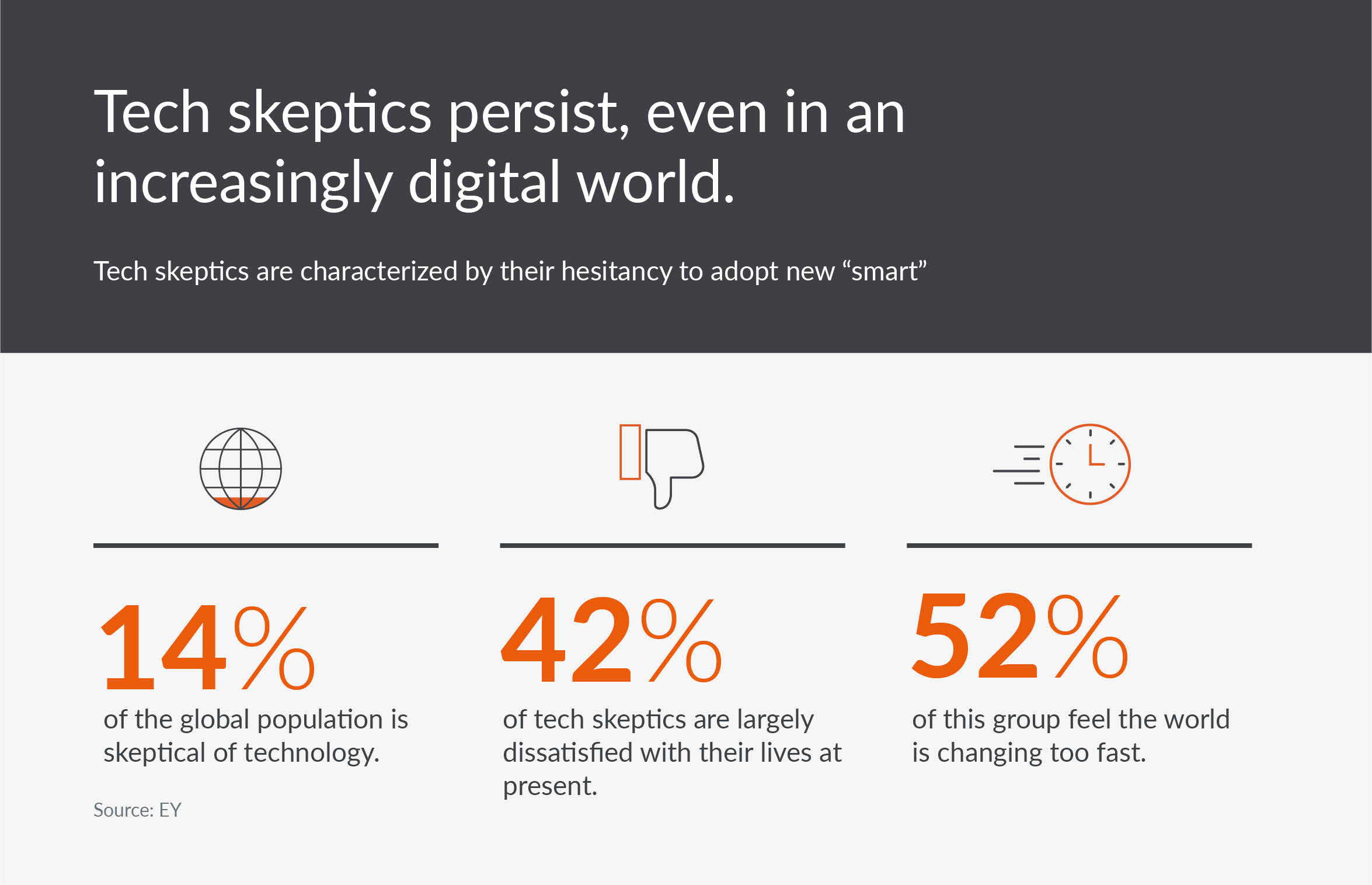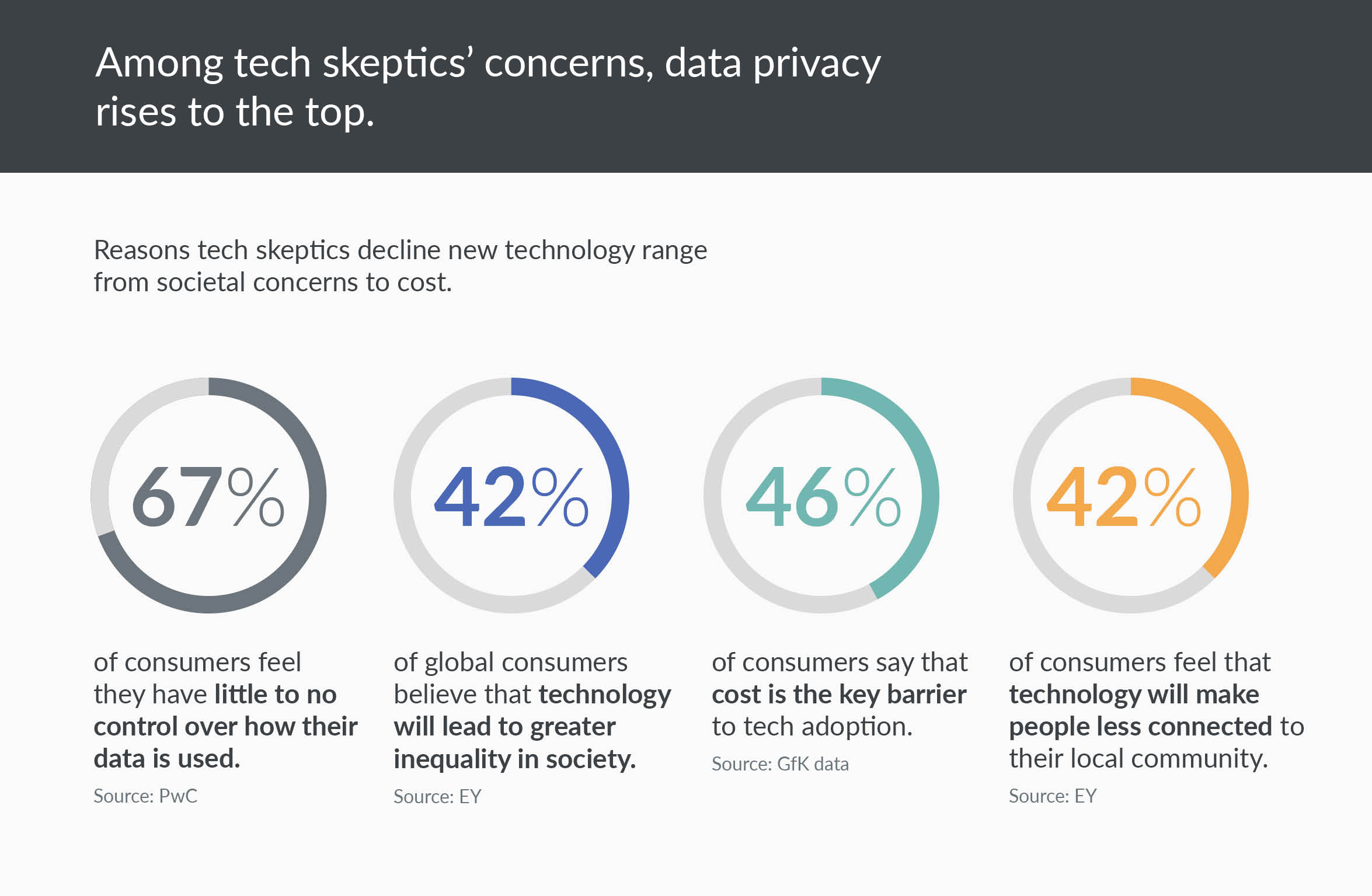From improved communications and increased productivity to time savings, the benefits of modern technology are numerous. But even in this digital age, not all consumers are convinced about the benefits of tech adoption. Enter the tech skeptics, a group of consumers who are concerned about the use of technology and the impact it has on the world at large. As Nevin Francis, GfK Strategic Insights Manager puts it, “These are people who are really cautious about how they go about adopting technology in their lives.”
This segment is a challenge for TCG brands seeking to gain traction for disruptive new consumer technologies. To win their trust, brands must lean into transparency and social responsibility, and respect tech skeptics’ desire for data protection and tech regulation. And to win them as customers, price is also another consideration.
It’s vital for TCG brands to have the best insights on the different types of tech skeptics, the factors they care about — and, ultimately, how brands can meet their expectations and build trust with them now and into the future.

Who are the tech skeptics?
With concerns spanning from data privacy, government regulation and the impact of technology on global inequality, tech skeptics are a group of consumers who are hesitant to purchase gadgets and smart home products or provide their personal data to businesses. According to research conducted by EY, they make up 14% of the total global population and are most widely represented in Germany, France, the UK, the US, Mexico, and Japan. Generally older and on lower incomes, they are also dissatisfied with their lives and fear things will be worse for future generations: EY identified that only 42% of this segment say they are satisfied with their quality of life at present, and 54% feel that the world is changing too fast.
“When a technology is introduced for the first time, skepticism is usually based on fear of the unknown or change. People see new technology as a potential disruptor to the way they currently do things,” explains Rick Kowalski, Director of Industry Analysis and Business Intelligence at the Consumer Technology Association.

While younger generations have grown up in an increasingly digital world, many older consumers have lived a good part of their lives without gadgets such as smartphones and computers — and this translates to tech resistance and anxieties about new technologies. In fact, older consumers are most likely to fall into this segment, with 78% of Baby Boomers exhibiting concern about their data privacy. “Some Baby Boomers find it hard to understand how to make a payment with just their phone or watch, and how their data is being used by a specific company,” says Nevin.
However, tech resistance or skepticism also runs high among young digital natives. According to the GfK Consumer Life Global: Asia Powerhouses report, Gen Z across Asian markets — especially Japan and South Korea — are most likely to feel uncertain or concerned about the future of technology, because they are more aware of its potential risks.
What are the barriers to tech adoption?
Tech skeptics’ resistance stems from several factors, most of which are rooted in fear of the unknown or a lack of understanding of how their data is used and shared. Many skeptics feel that technology will only exacerbate modern life and according to EY research, 42% believe that it will lead to greater inequality in society, and the same percentage feel that it will make people feel less connected to their local community. According to the GfK Consumer Life Worldwide 2021 report, such concerns are particularly high in developing Asia, where consumers are most likely to worry about the impact of technology on society.
For those who have already started to adopt smart technology, some have been disillusioned, with many consumers having experienced a data breach and research showing wide distrust in this area. For example, PwC research reveals that 67% of global consumers feel they have little to no control over how their data is used, and 60% say they expect the companies they do business with, to someday suffer a data breach. “We’re seeing this concern quite a bit, especially with smart home products and AI-powered devices,” notes Eric Wagatha, Head of Consumer Life at GfK.

Again, such concerns are especially high in Asia: according to the GfK Consumer Life Worldwide 2021 report, consumers in both developed and developing Asia are most likely to worry about their personal information getting into the wrong hands. On the other hand, consumers in Western Europe are least likely to harbor such fears.
In fact, smart home products represent the biggest concern for skeptics — many are unsure of the value, or feel that they are superfluous. 46% of global consumers say that cost is the key barrier to adoption, and price is cited as the number one barrier in 15 out of 21 countries across genders, generations, education levels, and income levels. Cost is a particular challenge in Latin America and in Asia, and “I don’t see the need for it” ranks third as a reason not to buy such products.
“We tend to see marketing around consumer electronics that tends to be very optimistic, highlighting how our lives will be improved and simplified as a result. But truth be told, the disjunct between what is promised and what is actually delivered still exists,” says Wagatha. And as Francis notes, “skepticism towards technology is driven by how useful its value proposition is.”
These are all important elements for brands to take into consideration as they develop a strategy and messaging to gain the trust of brand skeptics, but given the range of barriers to tech adoption, what should brands prioritize?
What can TCG brands do to build trust?
Focus on initiatives that ease data privacy and cybersecurity concerns
Given that some of the most striking data on tech skeptic behavior centers on data protection and cybersecurity, TCG brands should prioritize initiatives that assuage these concerns. Kowalski recommends that brands can showcase their trustworthiness by developing new features that allow customers to personalize the products and services they use — including settings that help consumers manage their privacy and security. For instance, Apple recently unveiled a new feature called App Tracking Transparency, which enables users to decide whether to allow individual apps to track their digital activity.

Building a resilient cybersecurity program can also go a long way to reassure consumers about data protection. “People are starting to believe that cyberattacks and cyber damages are inevitable,” says Chris Hallenbeck, Chief Information Security Officer at cybersecurity and systems management company Tanium. “While fraudsters have always been as ubiquitous as death and taxes, we can control the degree to which they cause a negative impact. To begin to change a helpless public mindset, it’s essential to prioritize greater cybersecurity awareness, prevention, and proactive risk assessment.”
Highlight the value of tech products to the everyday consumer
As many tech skeptics regard certain gadgets and appliances as excessive or unnecessary – especially when it comes to smart home products – TCG brands must underscore the usefulness of their products in their messaging. “Brands marketing their products to consumers must answer the question, ‘How does this help me?’ They must demonstrate how their technology fits into consumers’ everyday lives,” says Kowalski. “And there are many ways to showcase that value, whether it’s via social media or at trade shows such as CES.” His views are echoed by Wagatha, who believes that brands need to explain their products better.

Embrace the power of brand transparency
Brands can flex their ethical credentials to demonstrate that they are acting in the best interests of society to connect with younger consumers, who are more likely to prioritize ethical matters when deciding which brands to trust. According to Morning Consult, 18 to 29 year-olds in the US are more likely than the overall adult population to say it is “very important” that a company has strong ethical or political values.
Overall, brand transparency is key to breaking down tech resistance. “For a long time, self-motivated tech companies were able to operate in the background with few eyes on them, because it was just assumed they were serving the public interest. For vendors, that was a gift because it meant less scrutiny and accountability,” says Hallenbeck. “But in today’s climate where there is greater skepticism about the tech industry, vendors cannot — and should not — try to hide from their customers. Be open about your products, principles, practices, and vision. Work with your customers, not around them. Empower them with knowledge.”
Go beyond self-regulation
While brands should do everything in their power to build trust with their customers, stronger tech regulation is being demanded to help restore consumers’ faith in technology. “People don’t believe that there’s enough accountability in the tech industry,” says Hallenbeck. A recent report by Fleishman-Hillard highlights how 29% of global consumers believe that tech companies are not regulated enough, rising to 42% of Italians, 39% of Brits, and 35% of Canadians. Similarly, EY research shows that 41% of global consumers think tech companies should be subject to strong government regulation.
To this end, governing bodies around the world should consider implementing standards-based regulatory frameworks to provide greater transparency and clarity for consumers — and brands should welcome this as an opportunity to gain public trust. Ultimately, the right checks and balances can go a long way in breaking down tech resistance while still fostering a culture of innovation.
What does the future hold?
On one hand, the pandemic has accelerated tech adoption, with many consumers, including some of the skeptics, forced to turn to digital alternatives of typically in-person activities, such as grocery shopping. “During COVID-19, sales of mobile devices such as laptops and tablets and online shopping behavior actually increased,” notes Sohjin Baek, Strategic Insights Manager at GfK. This suggests that some skeptics are adopting digital services in light of social distancing and other restrictions, which could reduce their tech resistance in the future. “Overall, the pandemic has propelled tech adoption forward by five years,” says Nevin. The tide is turning and skeptics’ behavior is changing, so TCG brands can target this segment by providing and communicating transparency, security, and ease of use for their products and services.

Overall, however, the growing awareness is also resulting in increased concerns about digital risk, and this trend will continue if TCG brands fail to act. “Consumers are much wiser as to what’s available to them, and the ins and outs of product strengths and weaknesses,” says Wagatha. According to the Edelman Trust Barometer 2021, technology was the most trusted sector in the US in 2020, but it plummeted to the ninth spot in 2021, dipping below the neutral threshold into distrust for the first time ever. Confidence fell in 25 of the 27 countries surveyed, reaching all-time lows in 16 countries.
There’s a startling delta between this decline in consumer trust and how brands view their perception in the market. PwC research shows that 80% of businesses give themselves an A or B grade when it comes to data protection, but 28% of consumers say their trust in businesses’ technology has actually been falling.
To halt this backward slide, brands must focus on the initiatives that will have the most impact — providing best-in-class data protection measures, heralding the utility of their products for everyday consumers, and continuing to focus on transparency efforts that generate brand lift and goodwill. These just might be the key to converting tech skeptics into tech enthusiasts.
Want to discover more about the tech skeptics market segment?
FAQs
Who are tech skeptics?
Tech skeptics are consumers who are concerned about the use of technology and the impact it has on the world at large, and who often resist the adoption of new tech gadgets and solutions.
Why are these consumers skeptical about technology?
Their distrust of technology stems from several factors. Some consumers feel that technology contributes to greater inequality in society, and others cite data privacy concerns. Additionally, some consumers feel that technological products are costly and/or superfluous.
How can brands build trust with tech skeptics?
Brands must assuage tech skeptics’ concerns about privacy – for instance, by ensuring consent compliance and giving customers more control over their data. Additionally, brands must demonstrate that they act in the best interests of society.




